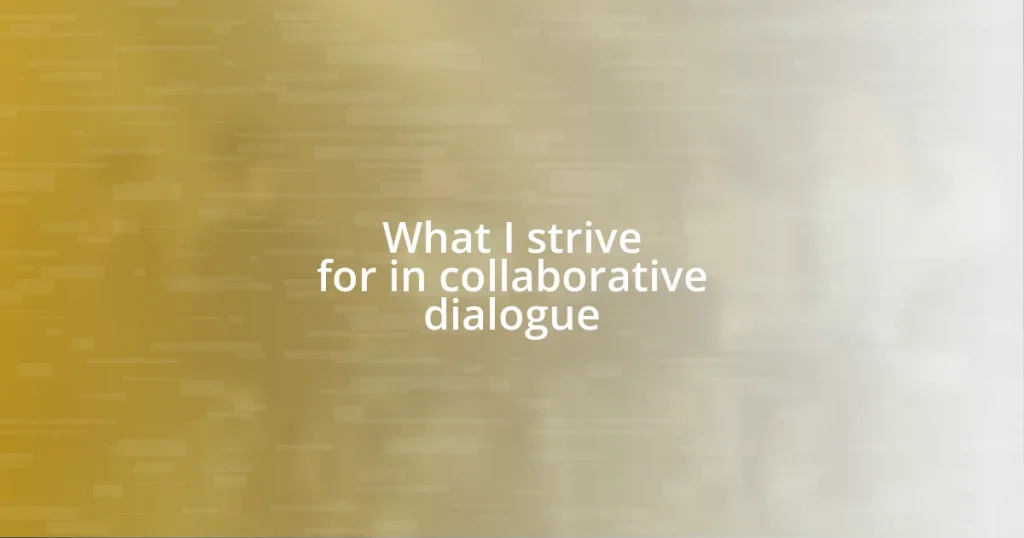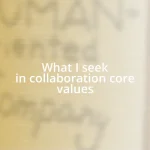Key takeaways:
- Collaborative dialogue fosters mutual understanding through active listening, openness to diverse perspectives, and empathy.
- Building trust is essential; sharing vulnerabilities and maintaining consistency strengthens relationships in conversations.
- Continuous improvement involves reflecting on discussions, incorporating feedback, and celebrating small wins to enhance collaborative efforts.
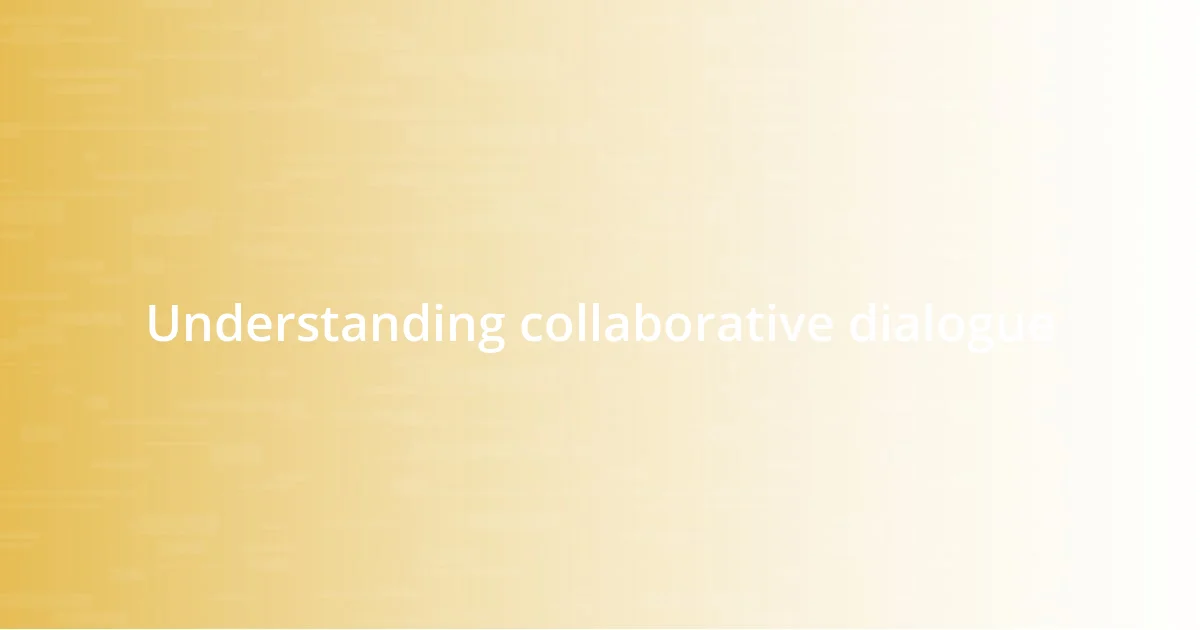
Understanding collaborative dialogue
Collaborative dialogue is about more than just exchanging ideas; it’s about creating a shared understanding. I remember a project where my team and I sat around a table, tossing ideas back and forth with genuine enthusiasm. Each person’s voice was valued, and that sense of participation made the final product far more enriched than if we’d worked in silos.
One key aspect that stands out to me is the notion of active listening. Have you ever felt unheard in a conversation? I know I have, and it’s frustrating. But when I truly listen to others, I notice how it transforms the dialogue. It’s not just about waiting for your turn to speak; it’s about engaging with what’s being said. This openness encourages vulnerability, allowing for a deeper connection and understanding among collaborators.
Furthermore, collaborative dialogue fosters an environment where diverse perspectives thrive. I once worked with a team that included members from various cultural backgrounds. Each person brought unique insights, which often led to surprising solutions that I hadn’t considered. It made me realize how essential it is to embrace differences. Isn’t it fascinating how sometimes the best ideas come from unexpected places? This exploration can lead to innovations that might not emerge in a more rigid setting.
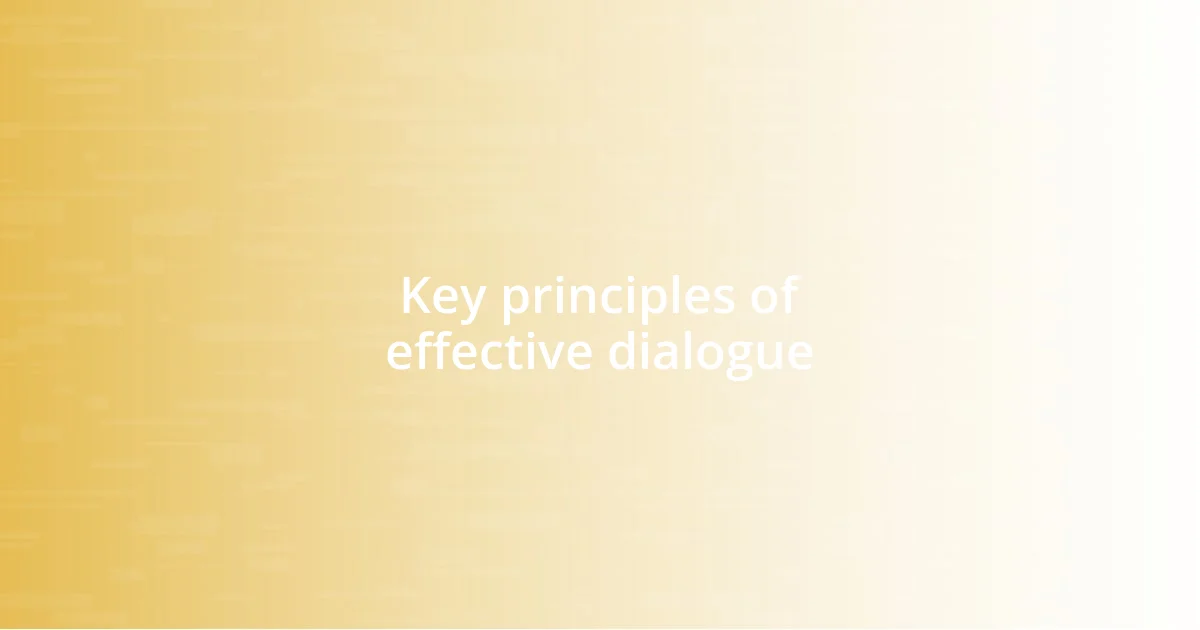
Key principles of effective dialogue
Effective dialogue rests on several key principles that foster mutual respect and understanding. For instance, maintaining an open-minded stance is vital. I recall a brainstorming session where one participant proposed an unconventional idea that initially made me skeptical. Yet, embracing that openness allowed us to explore the idea further, leading to a breakthrough that none of us had anticipated. It’s a powerful reminder that sometimes, the best paths forward come from those moments of uncertainty.
Here are some fundamental principles to keep in mind:
- Active Listening: Fully engage with what others are saying—it’s the foundation of genuine understanding.
- Openness to Different Perspectives: Embrace diverse opinions and approaches; they can unveil new possibilities.
- Empathy: Understand the feelings and experiences of others, as this deepens connections.
- Non-Defensive Communication: Approach disagreements with curiosity rather than reactively defending your stance.
- Constructive Feedback: Offer support and suggestions that help grow the dialogue rather than stifle it.
Each of these principles resonates with my experiences, reinforcing that dialogue is not just about talking; it’s about building relationships and fostering an environment where ideas flourish.

Strategies for active listening
Active listening serves as a cornerstone of effective communication. It requires a dedicated effort to focus on the speaker, understanding their message, and responding thoughtfully. I’ve found that sometimes, closing my eyes for a moment while someone speaks can help me concentrate better on their words, as strange as it may seem. This deliberate action minimizes distractions and allows me to engage fully with their ideas, ultimately enriching the conversation.
One strategy I utilize involves asking open-ended questions. For example, when a colleague shares their thoughts, I often respond with “Can you tell me more about that?” This encourages them to expand, providing deeper insights I might not have anticipated. I remember a time when a team member revealed an innovative approach during such a moment, leading us down an exciting path that reshaped our project. Isn’t it amazing how simple inquiries can unlock richer discussions?
Another powerful technique is mirroring. By reflecting back what someone has said, I demonstrate that I value their input. For instance, if a teammate expresses concern about a deadline, I might say, “It sounds like you’re feeling overwhelmed with the upcoming timeline.” This not only shows empathy but also opens the door for further dialogue. I learned this skill through a workshop I attended, and it has dramatically enhanced my interactions. Have you experienced the benefits of mirroring in your conversations?
| Strategy | Description |
|---|---|
| Active Listening | Fully engaging with the speaker and minimizing distractions to understand their message. |
| Open-Ended Questions | Encouraging deeper discussion by asking questions that require more than yes/no answers. |
| Mirroring | Reflecting back what the speaker says to show empathy and encourage further dialogue. |

Techniques for encouraging participation
One effective technique I often use to encourage participation is creating a safe space for sharing ideas. I remember a group discussion where I noticed some team members hesitated to voice their opinions. To change this, I started by sharing a personal failure related to the project, which helped to humanize the conversation. It’s remarkable how vulnerability can ignite a more open atmosphere—have you ever tried leading a discussion by first sharing something personal?
Another method that has proven successful is using visual aids or brainstorming tools. During a recent workshop, we employed a mind-mapping technique on a whiteboard, which transformed an overwhelming topic into a structured visual. I observed participants lighting up as they began to see connections between their thoughts. How can visuals shift your group discussions from abstract ideas to tangible concepts?
Additionally, I find it beneficial to rotate roles within meetings. By assigning different facilitation roles to team members, I’ve seen newfound enthusiasm and fresh perspectives emerge. In one instance, letting a quieter colleague lead our brainstorming session brought out excellent ideas that previously remained hidden. Does it surprise you how a simple shift in responsibility can make everyone feel like a valuable contributor?
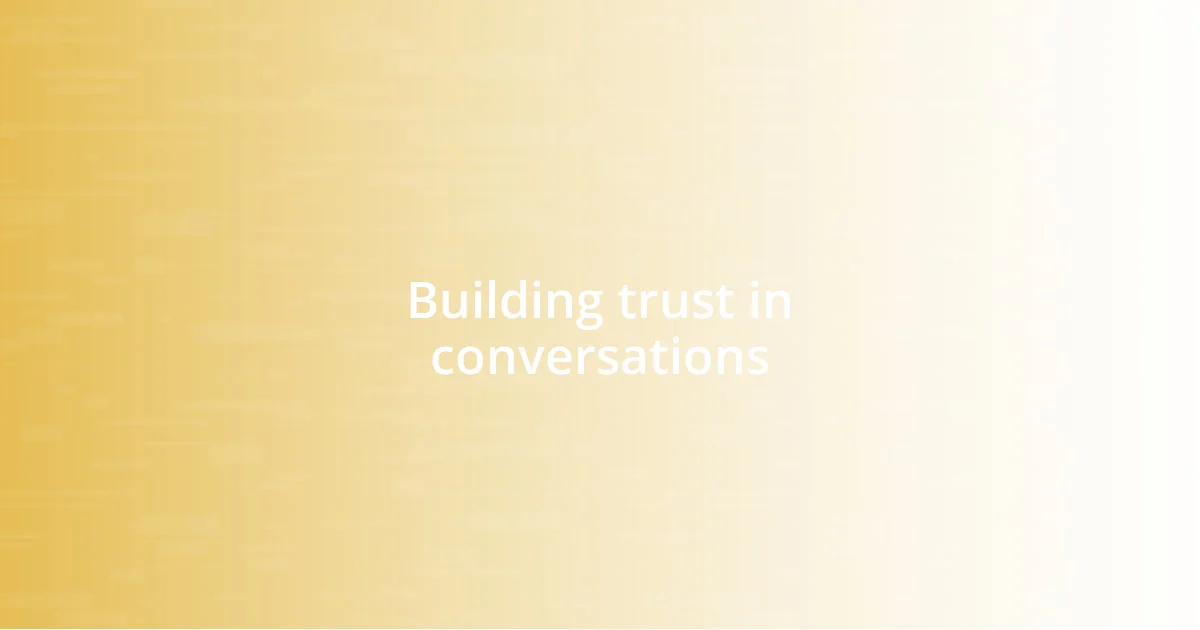
Building trust in conversations
Building trust in conversations is essential for fostering open and meaningful dialogue. I’ve found that vulnerability plays a key role in this process. One time, I shared my hesitations about a project during a meeting, and the reactions were eye-opening. When I opened up, others followed suit, revealing their own concerns and creating an atmosphere of mutual support. Have you noticed how revealing a bit of yourself can break down barriers?
Another aspect that builds trust is consistency. When I actively follow through on commitments made during discussions, it reassures my colleagues that their inputs matter. For example, after promising to consider a suggestion, I made it a point to incorporate that idea into our strategy. The look of appreciation on my teammate’s face was a reminder of how valuable trust is. Isn’t it inspiring to see how small actions can solidify relationships?
Additionally, practicing patience is crucial in building trust. I once had a long conversation with a coworker who was initially hesitant to share their thoughts. By giving them time and space to articulate their ideas without interruption, I noticed newfound confidence blossoming in them. The strength of our collaboration grew, which highlights how trust can evolve when we demonstrate respect for each other’s pace. How often do we rush past the moments that could cultivate deeper bonds?

Overcoming barriers to dialogue
Overcoming barriers to dialogue is crucial for effective communication. I vividly recall a project where differing opinions led to a tense atmosphere. Instead of letting it fester, I prompted each team member to share their perspective without rebuttals for a short period. This simple act of listening turned the tide, enabling understanding rather than conflict. What do you think happens when everyone feels heard?
Another common barrier is fear of judgment. I faced this firsthand when I hesitated to voice an unpopular opinion in a meeting. Eventually, I took a deep breath and expressed my thoughts, saying that sometimes the road less traveled leads to the most innovative solutions. To my surprise, others were relieved to be given the space to speak their minds too. Could embracing discomfort actually pave the way for richer discussions?
Additionally, timing can play a significant role in dialogue. There was a moment during a heated debate when I suggested pausing for a short break. This brief interlude allowed everyone to gather their thoughts and approach the conversation with renewed clarity. Afterward, we found the tensions had eased, and creative solutions flowed more freely. Have you ever noticed how a little time can change the entire dynamic of a discussion?
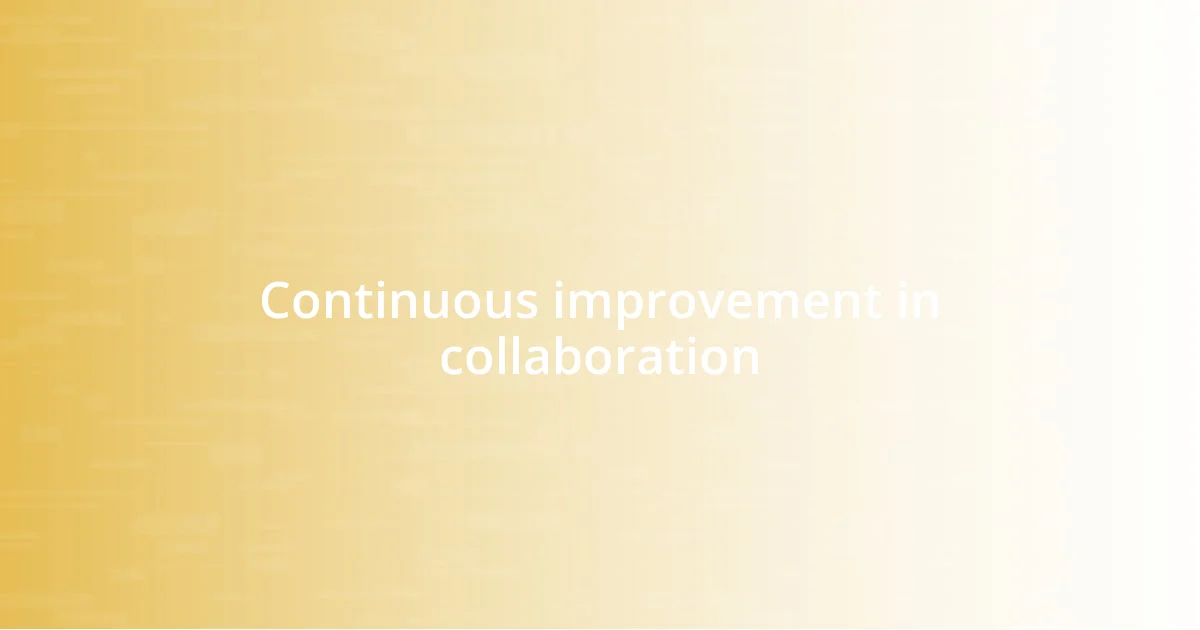
Continuous improvement in collaboration
Continuous improvement in collaboration hinges on our ability to reflect and adapt after each interaction. I remember attending a brainstorming session where we discussed various strategies for a project. After wrapping up, I felt we had a lot of ideas but lacked a clear direction. So, I suggested we hold a follow-up meeting to sift through our thoughts, refine our plans, and ensure clarity moving forward. That experience taught me how taking the time to reassess can lead to profound breakthroughs. Doesn’t it feel rewarding when dialogue evolves into actionable outcomes?
Another layer to this improvement process is the incorporation of feedback. Not long ago, I led a team discussion where we explored our communication styles. I asked for feedback on my own approach, and while it was daunting, the insights gained were invaluable. For instance, one colleague pointed out that I sometimes dominate the conversation. Recognizing that helped me consciously create space for others to contribute. Isn’t it amazing how seeking input can illuminate areas for growth that we might overlook ourselves?
Lastly, celebrating small wins in collaboration encourages a positive cycle of improvement. I recall a project milestone where our team came together to acknowledge everyone’s contributions. Sharing those moments boosted our morale and motivated us to tackle the challenges ahead with renewed vigor. Reflecting on progress not only strengthens our bonds but also fuels our commitment to collaboration. How often do you take the time to celebrate achievements, no matter how small?










